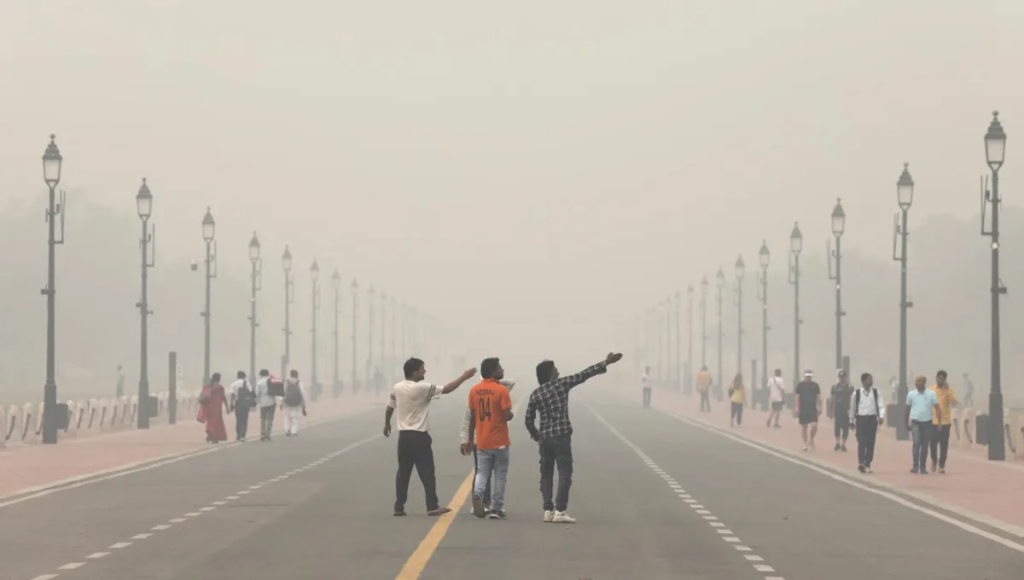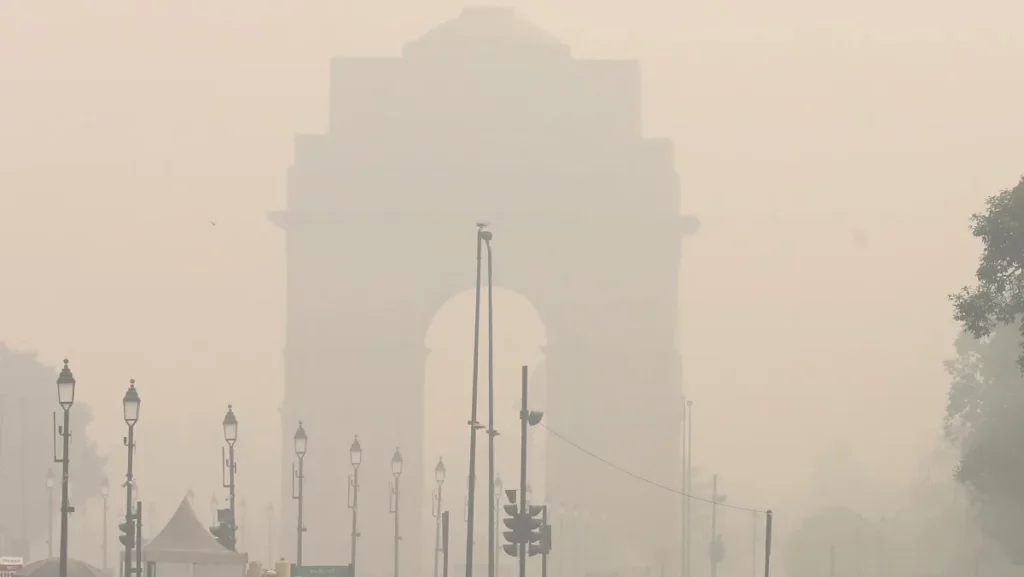In November last year, the capital of India, New Delhi, called for the closure of schools across the city, leaving an estimated four million, four hundred and seventy-six thousand students without the opportunity to learn from within their classrooms.
This was due to the implementation of GRAP-IV measures in response to ‘Sever Air Quality’ in Delhi. The Winter Break students would normally enjoy was preponed due to thick, choking air pollution that blanketed the city. Delhi has consistently placed among the cities with the highest amounts of air pollution, and placed fourth on a list of 50 cities worldwide with the highest PM2.5 levels, in 2022. That is, levels of particulate matter in the air that are 2 ½ microns or less in width. On November 6, 2023, the Air Quality Index (AQI), surpassed the top of the scale at 300, the top of the scale, crossing the threshold for hazardous levels of pollution.

People crossing railway tracks on a smoggy morning in New Delhi, India, on November 3, 2023. [Photo Source: Anushree Fadnavis/Reuters]
Yet, such a phenomenon is not unheard of in Delhi. The metropolis of over 33 million people receives a yearly pollution bomb during the post-monsoon season, which runs from October to December. Poor air quality plagues other cities across the country as well.
As Vinayak Sinha, an atmospheric scientist at the Indian Institute of Science Education and Research Mohali, says, “Every year it is the same story.”
Thus, researchers claimed that despite the attention Delhi’s air was receiving by the local media at the time, the surge was normal for the time of year. Still, ‘normalised’ or not, the issue of air pollution in India has continued as a silent epidemic year in and out, bringing with it a plethora of health and social implications. As the Hindu festival of Diwali kicked off on November 10, Delhi was already blanketed in choking smog and was bracing for pollution to worsen. Following the monsoon, the atmosphere had only become more contaminated.
At that time of year, the plentiful showers that had provided some respite and removed contaminants from the air patters to a halt as the season ends. The troposphere, or the lowest layer of the atmosphere, contracts as a result of a decline in temperature at the upper limit. This leads to a particle concentration increase in the pollutant soup of the troposphere. According to Karthik Ganesan, a policy researcher at the Council on Energy Environment and Water in New Delhi, the state of affairs last year still caught him off guard. This is because, in contrast to previous years, there was less crop waste burned in the nearby Punjab area, leading some people to anticipate a milder wave of pollution.
As it turned out, shifting climatic circumstances such as decreases in wind speed ensured that the quality of the air in the aftermath of the monsoon season was as poor as it had always been.

A street in the city is engulfed in heavy smog in New Delhi, India, on November 4, 2023. [Photo Source: Rajat Gupta/EFE-EPA]
According to Ganesan, the wind speed was a particularly deterministic factor as it meant local emissions were trapped in stagnant air. Behavioural changes brought on by weather variations were also said to increase emissions. Landfill fires and building activity often pick up after the wet months, and farmers burn agricultural waste after harvest to make way for fresh plantings outside of cities.
According to a 2019 study, crop burning in Delhi contributed 42 per cent of the black carbon. This pollutant causes haze formation with numerous negative health effects between the winter and autumn. According to an analysis of the System of Air Quality and Weather Forecasting and Research (SAFAR) data of previous years, crop fires contribute to 20 per cent of Delhi’s PM2.5 during the post-monsoon season on average, going as high as 70 per cent. In addition, Diwali fireworks exacerbate the annual wave of pollution as well, and raise the atmospheric concentrations of the dangerous metal ions that give the pyrotechnics their colour. Of course, air contaminants are also produced in considerable quantities by vehicle emissions and that produced from burning inefficient domestic fuels like firewood. Sarath Guttikunda, an atmospheric scientist and the Director of Urban Emissions, a non-governmental research centre in Goa, India, stated that this issue persists throughout the year — but truly worsens during this post-monsoon period.
What does this mean for Delhi’s metro population of millions? Everyone, including Delhi’s inhabitants, know very well how to decry pollution, a clear indication of which is the many who have left the city to find a life elsewhere. But just how acute are its effects?
How aware are we of its effects other than worsening common health conditions?
Interestingly, studies have linked air pollution to elevated stress levels, psychological discomfort, depression, and even a greater chance of dementia and Alzheimer’s disease. The effects of pollution thus extend well beyond physiological symptoms, with impacts on one’s mental health which can affect one’s day-to-day life.
A New Epidemic

Smoke emanating from burning refuse, in Gurugram, India on November 2, 2023. [Photo Source: The Press Trust of India]
Additional studies have also connected persons with severe mental illnesses to a higher risk of death when they are exposed to short-term highs in air pollution.
The effects of pollution on children’s brains and mental health has increasingly been a topic of study with greater awareness for mental health in recent years. For instance, exposure to air pollution “is significantly associated with increased risk of psychiatric disorders” such as depression, schizophrenia, as well as bipolar and other personality disorders, according to research including participants from the United States and Denmark. Another recent study concluded a link between air pollution and a higher incidence of depressive symptoms and suicidal thoughts or behaviours in children and adolescents in crucial stages of brain development.
Children growing up in the 21st Century, therefore, may be facing a unique epidemic their predecessors did not need to contend with, with little exposure and knowledge to assist them.
This is exacerbated by the fact that adverse climate conditions show little chance of improving in the future without radical reform. Children are far more susceptible to health risks because of the ongoing development in their bodies, organs, and immune systems, with neuroimaging investigations showing evidence of anatomical and functional alterations, due to the effects of pollution. Those made ill throughout childhood would also have a higher chance of developing chronic illnesses later in life, such as allergies, asthma, diminished lung function and respiratory infections. Yet this vulnerable demographic remains helpless, unable to influence regulations about the air quality around them.
In addition to breathing more quickly than adults do, children also inhale more air per kilogram of body weight. They breathe air closer to the ground because of their lower height, which is where some pollutants, particularly from vehicle exhausts, are released in concentrate. Compared to adults as well, children breathe in a higher percentage of air via their lips. This increased oral breathing means the more porous lower respiratory tracts of children may be deeply penetrated by pollutants.

A young boy breathes through a respirator. [Photo Source: India Today]
The Hidden Cost of Pollution
Reducing air pollution in child-centric settings, such as schools and kindergartens, can help minimise exposure to it until general air pollution is brought down to acceptable levels. Though lung health is the main topic of conversation when it comes to pollution, there are other, more clandestine, effects, particularly for the younger generation that is growing up indoors and wearing masks. In addition, when schools are closed and students must stay inside, they miss out on the peer culture that fosters community and a positive social atmosphere.
Since social and cognitive capabilities are still growing at that age, it is crucial that children are able to move about, socialise, and learn how to communicate with others. We all require some form of stimulation as we grow up, and that is socialisation. Additionally, a study conducted at AIIMS (All India Institute of Medical Sciences) found that behavioural issues and psychiatric morbidities are co-occurring in children and adolescents with bronchial asthma — yet they remain underexplored and often ignored in clinical settings. This can impact the child’s overall quality of life.
In another statistic, irregular school attendance was reported by 23.33 per cent of the participants with asthma. About 17 per cent of the thirty participants in the study were diagnosed with specific phobias, 10 per cent with conduct disorder, and seven per cent with attention deficit hyperactivity disorder (ADHD). Participants also suffered significantly more behavioral syndromes such as anxiety and depression.

Schoolgirls protect themselves amid heavy pollution. [Photo Source: Hans India]
Thus, there is sufficient documentation to prove that the children of today are growing up with a novel issue largely unbeknownst to their parents before them.
Without proper awareness of the physiological and social impacts of pollution on the youth of India, the silent epidemic would rage on, uninhibited for years to come. In fact, it has been 10 years since the World Health Organization (WHO) deemed the city to be the most polluted in the world – ranking worse than Beijing whose air quality was notorious at the time.
Although there has been progress, Delhi is still often labelled as the most polluted capital in the world. However, the city is ‘doing its bit‘, according to Reena Gupta, the national spokesperson of Delhi’s governing party, Aam Aadmi Party – even at the cost of losing revenue to reduce pollution. She cites a recent study which shows only about a third of the pollution sources are within the megacity’s boundary: “In Delhi, we have converted all the industry to clean and natural gas. Why has that not happened in Gurgaon and Ghaziabad [which border Delhi]?”
Hence, grappling with Delhi’s pollution levels requires a nationwide response.
Regulations such as those regarding fuel source conversions are difficult and expensive to enforce, unless more robust government as well as conscious civilian efforts are involved such as using lesser cars or switching to hand-powered equipment.
Delhi’s pollution crisis will not be alleviated easily in the next few years. However, there may be opportunities for improvement in the distant future if strict action is taken as soon as possible, such as on crop burning and factory fumes in nearby states and cities, and eventual conversion of fuel sources.
Until then, the youth of India’s megacity will continue to pay the price of their country’s pollution epidemic.



